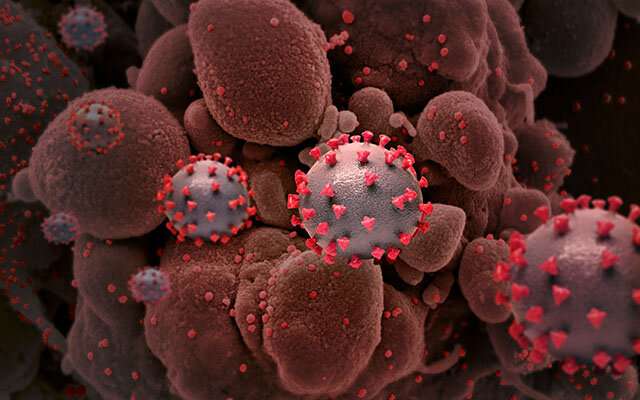
One in eight adults (12.7%) who are infected with SARS-CoV-2 experience long term symptoms due to COVID-19, suggests a large Dutch study published in The Lancet.
The study provides one of the first comparisons of long-term symptoms after SARS-CoV-2 infection (often called ‘long COVID’) with symptoms in an uninfected population, as well as measuring symptoms in individuals both pre- and post-COVID-19 infection. The inclusion of uninfected populations enables a more accurate prediction of long-term COVID-19 symptom prevalence as well as improved identification of the core symptoms of long COVID.
“There is urgent need for data informing the scale and scope of the long-term symptoms experienced by some patients after COVID-19 illness.” says Prof Judith Rosmalen from the University of Groningen, lead author of the study. “However, most previous research into long COVID has not looked at the frequency of these symptoms in people who haven’t been diagnosed with COVID-19 or looked at individual patients’ symptoms before the diagnosis of COVID-19.”
Prof Rosmalen continues, “Our study approach looks at the symptoms most often associated with long COVID, including breathing problems, fatigue and loss of taste and/or smell, both before a COVID-19 diagnosis and in people who have not been diagnosed with COVID-19. This method allows us to take pre-existing symptoms and symptoms in non-infected people into account to offer an improved working definition for long COVID and provide a reliable estimate at how likely long COVID-19 is to occur in the general population.”
In this new study conducted in the Netherlands, researchers collected data by asking participants of the population-based Lifelines COVID-19 Cohort to regularly fill out digital questionnaires on 23 symptoms commonly associated with long COVID. The questionnaire was sent out 24 times to the same individuals between March 2020 and August 2021 meaning participants who had COVID-19 during this time were infected with the SARS-CoV-2 alpha-variant or earlier variants. Most of the data was collected before the COVID-19 vaccine rollout in The Netherlands so the number of vaccinated participants was too small to analyze in this study.
Participants were recorded as COVID-19 positive if they had either a positive test or a doctor’s diagnosis of COVID-19. Of 76,422 participants, 4,231 (5.5%) participants who had COVID-19 were matched to 8,462 controls taking account of sex, age and time of completing questionnaires that indicated a COVID-19 diagnosis.
The researchers found that several symptoms were new or more severe three to five months after having COVID-19, compared to symptoms before a COVID-19 diagnosis and to the control group, suggesting these symptoms can be viewed as the core symptoms of long COVID.
The core symptoms recorded were chest pain, difficulties breathing, pain when breathing, painful muscles, loss of tase and/or smell, tingling hands/feet, a lump in throat, alternately feeling hot and cold, heavy arms and/or legs and general tiredness. The severity of these symptoms plateaued at three months after infection with no further decline. Other symptoms that did not significantly increased three to five months after a COVID-19 diagnosis included headache, itchy eyes, dizziness, back pain and nausea.
Ph.D. candidate and first author of the study, Aranka Ballering says, “These core symptoms have major implications for future research, as these symptoms can be used to distinguish between post COVID-19 condition and non-COVID-19-related symptoms.”
Of the study participants who had submitted pre-COVID symptom data, the researchers found that 21.4% (381/1,782) of COVID-19-positive participants, compared to 8.7% (361/4,130) of the control group, experienced at least one increased core symptom at moderate severity 3 months or more after SARS-CoV-2 infection. This implies that in 12.7% of COVID-19 patients their new or severely increased symptoms three months post-COVID can be attributed to SARS-CoV-2 infection.
Aranka Ballering adds, “By looking at symptoms in an uninfected control group and in individuals both before and after SARS-CoV-2 infection, we were able to account for symptoms which may have been a result of non-infectious disease health aspects of the pandemic, such as stress caused by restrictions and uncertainty.”
She continues, “Post-COVID-19 condition, otherwise known as long COVID, is an urgent problem with a mounting human toll. Understanding the core symptoms and the prevalence of post-COVID-19 in the general population represents a major step forward for our ability to design studies that can ultimately inform successful healthcare responses to the long-term symptoms of COVID-19.”
The authors acknowledge some limitations in the study. This study included patients infected with the alpha variant or earlier variants of SARS-CoV-2 and has no data from people infected during the period when the delta or omicron variants were causing most infections. Additionally, due to asymptomatic infection, the prevalence of COVID-19 in this study may be underestimated. Another limitation to this study is that since the beginning of data collection other symptoms, such as brain-fog, have been identified as potentially relevant for a definition of long COVID but this study did not look at these symptoms. Furthermore, the study was undertaken in one region and did not include and ethnically diverse population.
Prof Judith Rosmalen says “Future research should include mental health symptoms (e.g. depression and anxiety symptoms), along with additional post-infectious symptoms that we could not assess in this study (such as brain fog, insomnia, and post-exertional malaise). We were unable to investigate what might cause any of the symptoms observed after COVID-19 in this study, but we hope future research will be able to give insights into the mechanisms involved. Furthermore, due to the timing of this study we were unable to assess the effect of COVID-19 vaccination and different SARS-CoV-2 variants on long COVID symptoms. We hope future studies will provide answers on the impacts of these factors.”
Source: Read Full Article